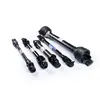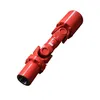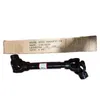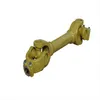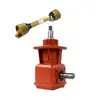A PTO shaft, or Power Take-Off shaft, is a mechanical component that transfers power from a tractor or engine to an attached implement, such as a mower, baler, or tiller. It is a critical part of agricultural and industrial machinery, ensuring efficient power transmission for various tasks. PTO shafts are designed to handle high torque and rotational speeds, making them essential for heavy-duty applications.
| Model | Length (inches) | Diameter (inches) | Max Torque (Nm) | Max RPM | Weight (lbs) |
|---|---|---|---|---|---|
| PS-100 | 36 | 1.375 | 500 | 1000 | 15 |
| PS-200 | 48 | 1.75 | 800 | 900 | 22 |
| PS-300 | 60 | 2.0 | 1200 | 800 | 30 |
| PS-400 | 72 | 2.5 | 1500 | 700 | 40 |
PTO shafts are used in various industries, including agriculture, construction, and landscaping. Common applications include powering rotary cutters, hay balers, wood chippers, and irrigation pumps. Their versatility makes them indispensable for farmers and contractors who need reliable power transfer for their equipment.
What does PTO stand for?
PTO stands for Power Take-Off, which refers to the method of transferring power from a source to an implement.
How do I choose the right PTO shaft for my machine?
Consider factors like the required length, diameter, torque capacity, and RPM ratings. Always match the shaft specifications to your machinery's requirements and consult the manufacturer's guidelines.
Can I repair a damaged PTO shaft?
Yes, many PTO shafts can be repaired by replacing worn parts like universal joints or yokes. However, if the shaft is severely bent or cracked, it is safer to replace it entirely to avoid accidents.
What maintenance does a PTO shaft need?
Regular maintenance includes lubricating the universal joints, checking for wear or damage, ensuring safety guards are intact, and storing the shaft in a dry place to prevent rust.
Are PTO shafts universal?
While many PTO shafts have standard fittings, they are not universally compatible. Always verify the shaft model and specifications with your equipment to ensure proper fit and function.
What safety precautions should I take with PTO shafts?
Always disengage the PTO before attaching or detaching implements, keep safety guards in place, avoid loose clothing near moving parts, and never operate the machinery without proper training.
How long does a PTO shaft typically last?
With proper maintenance and normal use, a high-quality PTO shaft can last for many years, often 5-10 years or more, depending on the application and operating conditions.
Can I use a PTO shaft with higher torque capacity than required?
Yes, using a shaft with a higher torque rating can provide added durability and safety, but ensure it fits properly and does not cause imbalance or other issues.
What are the signs of a failing PTO shaft?
Common signs include unusual noises, vibration, difficulty in engaging or disengaging, visible wear on joints, or leakage of lubricant. Address these issues promptly to prevent failure.
Do PTO shafts come with warranties?
Most manufacturers offer warranties, typically ranging from 1 to 5 years, covering defects in materials and workmanship. Check the product details for specific warranty information.
